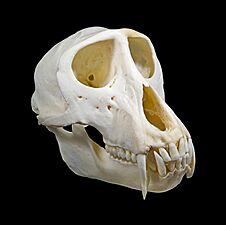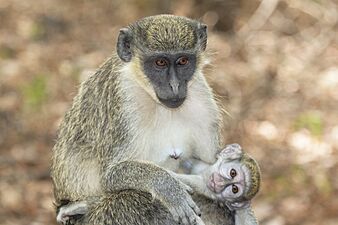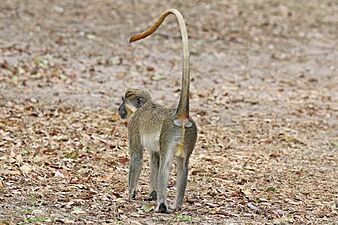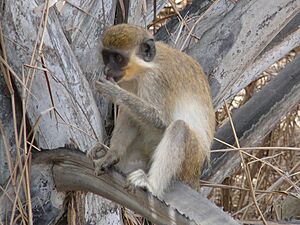Green monkey facts for kids
Quick facts for kids Green monkey |
|
|---|---|
 |
|
| Female with juvenile, Gambia | |
| Conservation status | |
| Scientific classification | |
| Genus: |
Chlorocebus
|
| Species: |
sabaeus
|
 |
|
| Geographic range | |
The green monkey (Chlorocebus sabaeus), also called the sabaeus monkey, is a type of Old World monkey. It has beautiful golden-green fur. Its hands and feet are pale, and the tip of its tail is golden yellow. The backs of its thighs and its cheek whiskers are also golden. Unlike some other monkeys in its group, it doesn't have a special band of fur on its forehead. Some scientists think that the green monkey and all other monkeys in its group, Chlorocebus, are actually one big species called C. aethiops.
Contents
Meet the Green Monkey: Physical Traits
Green monkeys show sexual dimorphism. This means that males and females look a bit different in size. Males are usually a little bigger than females.
Wild adult male green monkeys typically weigh between 3.9 and 8.0 kg (8.6 and 17.6 lbs). They measure about 420 to 600 mm (1.38 to 1.97 ft) long. Females are usually smaller. They weigh between 3.4 and 5.3 kg (7.5 and 11.7 lbs). Their length is typically between 300 and 495 mm (0.98 and 1.62 ft).
Where Green Monkeys Live
Green monkeys live in many different types of wooded areas. You can find them in very dry Sahel woodlands. They also live near the edges of rainforests. These monkeys are often seen in coastal regions too. In these areas, they are known to eat foods found on the seashore, like crabs. They also enjoy a wide variety of other foods. These include fruits and small creatures without backbones, called invertebrates.
Green Monkey Habitats Around the World
The green monkey is originally from West Africa. It lives in countries like Senegal and The Gambia. Its range extends all the way to the Volta River.
These monkeys have also been brought to other places. They were introduced to the Cape Verde islands. These islands are off the coast of north-western Africa. This happened as early as the second half of the 16th century. They live on the islands of Santiago and Brava.
Green monkeys were also brought to some West Indian islands. These include Saint Kitts, Nevis, Saint Martin, and Barbados. This happened in the late 17th century. They arrived on slave ships coming from West Africa. Today, a small group of green monkeys lives in Broward County, Florida. These monkeys are descendants of zoo animals that escaped in the 20th century.
Green Monkey Behavior and Communication
Like other monkeys in the Chlorocebus group, green monkeys are very social animals. They usually live in groups. These groups can have anywhere from 7 to 80 monkeys. Within these groups, there is a clear social order. You can see this in how they groom each other. You can also see it in how males and females interact.
Green monkeys communicate in many ways. They use both sounds and body language. They have special calls to warn their group about predators. They even have different calls for different types of predators! Body language is also used to signal danger. It can also show which monkeys are in charge. Scientists have also seen green monkeys use facial expressions. These expressions can show how they are feeling.
Reproduction and Life Cycle
Green monkeys live in a social system where one or a few dominant males lead the group. These alpha males play a key role in the group's social interactions. They also influence mating within the group.
These monkeys breed during certain times of the year. They usually breed from April to June. In some areas, like Nyes (northwest of Thies), they breed in October and November. These are the months when rainfall is heaviest. During the rainy season, fruit is most plentiful. Scientists believe green monkeys plan their breeding around this time. This way, there is plenty of food for mothers and their young.
Green monkeys usually breed about once a year. Males become old enough to breed at five years old. Females can breed when they are two years old. Sadly, many young monkeys do not survive. About 57% of infant monkeys die. However, green monkey mothers take great care of their babies. They look after their young for about a year. After that, the young monkeys are ready to explore and live more independently.
Gallery
-
Male, Senegal
-
Young adult, The Gambia
-
Male, Senegal








